|
|

Pathology >
Forest Pathology > Root and Butt Rot
Root and Butt Rot: a sustainable forestry issue
Mike Cruickshank
and Duncan Morrison, Pathologists
Canadian Forest Service, Pacific Forestry
Centre,
Victoria, British Columbia, Canada
Don Norris,
Pathologist,
B.C. Ministry
of Forests, Nelson Region
Introduction
Heterobasidion annosum Phellinus
weirii


Armillaria ostoyae
Inonotus tomentosus
 
The most common and damaging root and butt rots in British Columbia are
caused by the fungi (Clockwise from top left) Heterobasidion annosum
(1), Phellinus weirii (2), Armillaria ostoyae (3) and
Inonotus tomentosus (4). Fruiting structures, shown above, and
decayed wood can be used to identify the fungi.
 Disease
caused by root and butt rot fungi are the result of an interaction among
the pathogen, the host and the environment. In undisturbed stands, the
host and fungus become balanced over time. Forestry operations may upset
the balance by creating stumps and wounds that the fungi can colonize,
and by altering species composition on site. Disease
caused by root and butt rot fungi are the result of an interaction among
the pathogen, the host and the environment. In undisturbed stands, the
host and fungus become balanced over time. Forestry operations may upset
the balance by creating stumps and wounds that the fungi can colonize,
and by altering species composition on site.
 These
fungi move underground from stumps to new hosts at root contacts (above)
and by rhizomorphs in the case of Armillaria (right). Except for Annosus
root and butt rot, they rarely spread by spores. Factors affecting the
quantity or timing of root contacts will affect disease dynamics. These
fungi move underground from stumps to new hosts at root contacts (above)
and by rhizomorphs in the case of Armillaria (right). Except for Annosus
root and butt rot, they rarely spread by spores. Factors affecting the
quantity or timing of root contacts will affect disease dynamics.

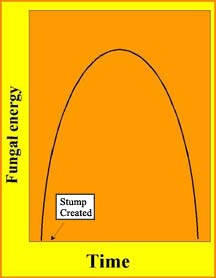 Fungal
energy rises as stumps become colonized by the fungi and then drops as
the wood decays. The duration and intensity of the fungus' energy is determined
by the size of the stump. Larger stumps provide more energy for infection
and take longer to decay. Fungal
energy rises as stumps become colonized by the fungi and then drops as
the wood decays. The duration and intensity of the fungus' energy is determined
by the size of the stump. Larger stumps provide more energy for infection
and take longer to decay.
In juvenile coniferous stands, the probability of a tree being infected
by Armillaria root disease increases with dbh and it is higher in stands
on sites in the moist climatic region than on sites in the wet or dry
regions. When infected trees are cut, the fungus can colonize the stump.
 Aboveground
symptoms of root and butt rot are seen only on trees with more than two-thirds
of their roots infected. About one-half of trees infected below ground
by Armillaria root disease can be detected above ground on dry sites compared
to one-quarter on moist sites. Aboveground
symptoms of root and butt rot are seen only on trees with more than two-thirds
of their roots infected. About one-half of trees infected below ground
by Armillaria root disease can be detected above ground on dry sites compared
to one-quarter on moist sites.
Effects of Root and Butt Rot
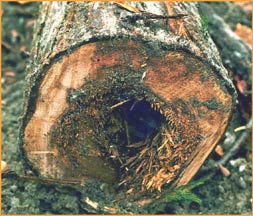 The
fungi enter through the roots and decay the lower stem and roots. Internal
decay usually does not cause detectable symptoms or signs. Loss of volume,
wood quality and fixed carbon occurs. The
fungi enter through the roots and decay the lower stem and roots. Internal
decay usually does not cause detectable symptoms or signs. Loss of volume,
wood quality and fixed carbon occurs.

Internal decay of roots weakens the anchorage of the tree and can predispose
it to windthrow.

Internal decay weakens the stem and can predispose it to wind breakage.
 The
Skimikin trial was established in 1968 to determine if removing infected
stumps of the previous stand could reduce mortality from Phellinus and
Armillaria root diseases, both of which occur on the site. One-half of
the site was whole tree logged (T) and the other was harvested conventionally
(U). Plots were planted with seedlings of the six tree species graphed
above. After 30 years, cumulative mortality from the two root diseases
is less than 4% in stumped plots, whereas in untreated plots, it is more
than 20% for most species. The
Skimikin trial was established in 1968 to determine if removing infected
stumps of the previous stand could reduce mortality from Phellinus and
Armillaria root diseases, both of which occur on the site. One-half of
the site was whole tree logged (T) and the other was harvested conventionally
(U). Plots were planted with seedlings of the six tree species graphed
above. After 30 years, cumulative mortality from the two root diseases
is less than 4% in stumped plots, whereas in untreated plots, it is more
than 20% for most species.
 Only
one-quarter to one-half of infected trees show aboveground symptoms of
root disease; symptomatic trees are usually killed by the fungi. Trees
with non-lethal, asymptomatic infections use energy that would normally
go to growth to defend themselves. The tree on the right had been infected
for 6 years and had about 40% less volume than the uninfected one on the
left; both were initially growing at the same rate. The amount of growth
lost in a stand is directly related to the number of infections on trees
and the number of infected trees. The loss goes undetected and over time
results in site index being underestimated and a longer rotation to reach
a given volume. Only
one-quarter to one-half of infected trees show aboveground symptoms of
root disease; symptomatic trees are usually killed by the fungi. Trees
with non-lethal, asymptomatic infections use energy that would normally
go to growth to defend themselves. The tree on the right had been infected
for 6 years and had about 40% less volume than the uninfected one on the
left; both were initially growing at the same rate. The amount of growth
lost in a stand is directly related to the number of infections on trees
and the number of infected trees. The loss goes undetected and over time
results in site index being underestimated and a longer rotation to reach
a given volume.
Silviculture
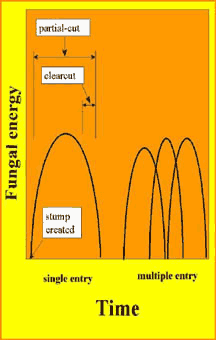 Forestry
practices affect the incidence and severity of root and butt rots. Most
of the effects occur because practices that create stumps or wounds increase
the amount of fungal inoculum. The figure on the right shows how selective-cutting
maximizes the time that residual trees are exposed to the fungus. This
occurs because root contacts among trees are already established at the
time of cutting, whereas in a clearcut (below left), the root contacts
between regeneration trees and stumps do not occur for about 10-15 years
after cutting. Forestry
practices affect the incidence and severity of root and butt rots. Most
of the effects occur because practices that create stumps or wounds increase
the amount of fungal inoculum. The figure on the right shows how selective-cutting
maximizes the time that residual trees are exposed to the fungus. This
occurs because root contacts among trees are already established at the
time of cutting, whereas in a clearcut (below left), the root contacts
between regeneration trees and stumps do not occur for about 10-15 years
after cutting.
 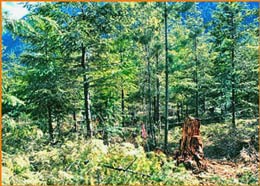
 Most
at risk are trees in uneven-aged stands (right) where residual trees that
now form the overstory have become infected by the fungus in the stumps.
The understory that has regenerated will become infected when root contacts
become established between these trees and the dying overstory. The risk
of damage is intermediate in shelterwood cuts, while clearcuts have the
lowest risk. Juvenile spacing (above right), and brushing and weeding
also leave stumps and lower the below ground diversity of roots that prevent
root contacts between susceptible tree species; however, the risk of damage
is lower than in older selectively-cut stands because stump size is smaller.
Multiple entries (see graph above right) maintain high fungal energy high
because the stumps that feed the fungus become available at regular intervals. Most
at risk are trees in uneven-aged stands (right) where residual trees that
now form the overstory have become infected by the fungus in the stumps.
The understory that has regenerated will become infected when root contacts
become established between these trees and the dying overstory. The risk
of damage is intermediate in shelterwood cuts, while clearcuts have the
lowest risk. Juvenile spacing (above right), and brushing and weeding
also leave stumps and lower the below ground diversity of roots that prevent
root contacts between susceptible tree species; however, the risk of damage
is lower than in older selectively-cut stands because stump size is smaller.
Multiple entries (see graph above right) maintain high fungal energy high
because the stumps that feed the fungus become available at regular intervals.
Reducing and Avoiding the Fungus
 There
are few options for reducing the impact of root and butt rots. The fungi
are very difficult and expensive to remove from the site once their presence
is magnified by forest practices. To avoid increasing the amount of fungal
inoculum, avoid practices that create stumps, and take care not to damage
the roots and stem of residual trees. If stumps or root systems can not
be removed then keep stump size as small as possible. Planting non-host
species in high hazard areas will reduce the incidence of Phellinus and
Tomentosus root rots. Annosus and Armillaria root rots have a large host
range, and only tree species with a low susceptibility can be used on
sites where these fungi are a problem. Low susceptibility species may
still get infected, and their growth will be reduced, but the risk of
mortality is lowered. Leaving sites fallow by planting grass for about
a decade should also reduce the amount of fungus on site. Where juvenile
spacing is required in high hazard areas, or in moderate hazard areas
with highly susceptible species, remove the whole tree, including roots,
with a pop-up spacer (left) to reduce or prevent inoculum build-up. The
pop-up spacer can also be used to commercially thin and selectively log
stands (below right). There
are few options for reducing the impact of root and butt rots. The fungi
are very difficult and expensive to remove from the site once their presence
is magnified by forest practices. To avoid increasing the amount of fungal
inoculum, avoid practices that create stumps, and take care not to damage
the roots and stem of residual trees. If stumps or root systems can not
be removed then keep stump size as small as possible. Planting non-host
species in high hazard areas will reduce the incidence of Phellinus and
Tomentosus root rots. Annosus and Armillaria root rots have a large host
range, and only tree species with a low susceptibility can be used on
sites where these fungi are a problem. Low susceptibility species may
still get infected, and their growth will be reduced, but the risk of
mortality is lowered. Leaving sites fallow by planting grass for about
a decade should also reduce the amount of fungus on site. Where juvenile
spacing is required in high hazard areas, or in moderate hazard areas
with highly susceptible species, remove the whole tree, including roots,
with a pop-up spacer (left) to reduce or prevent inoculum build-up. The
pop-up spacer can also be used to commercially thin and selectively log
stands (below right).
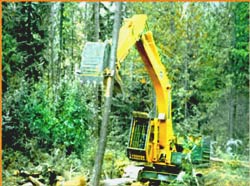 If
pop-up treatments are not an option, then keep stump size small, and favor
healthy low susceptible species as leave trees. Push-over harvesting (right)
removes the root system from the soil. On conventionally logged sites,
an excavator is the only option (below) for removing stumps. If
pop-up treatments are not an option, then keep stump size small, and favor
healthy low susceptible species as leave trees. Push-over harvesting (right)
removes the root system from the soil. On conventionally logged sites,
an excavator is the only option (below) for removing stumps.
 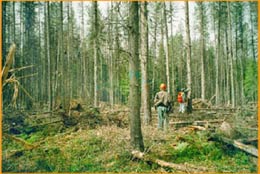
Conclusions
One or more of the fungi that cause these root and butt rots occur in
every forested ecosystem and are normal components of the belowground
environment. Due to their common occurrence, longevity, and the magnitude
of their effects, they must be considered as primary ecological regulators.
Root and butt rots are difficult to detect visually aboveground. In undisturbed
stands the fungi are usually in dynamic equilibrium with the trees, but
their presence represents a pathological legacy that easily transfers
from unmanaged stands to managed stands that will persist from rotation
to rotation. Forest management practices that create stumps and wound
residual trees increase the incidence and severity of root and butt rots
over that which would normally occur in nature; consequently increasing
fungal inoculum and the probability of trees contacting inoculum. Build-up
of the fungi on sites leads to mortality and growth loss, thereby reducing
ecosystem productivity. The long-term threat of these fungi if improperly
managed is of considerable concern for sustainable forest management.
References
- Hunt, R.S., and Unger, L. 1994. Tomentosus
root disease. Canadian Forest Service, Forest Pest and Disease Survey,
Pacific Forestry Center. Forest Pest Leaflet no. 77, 7p.
- Morrison, D. J., Merler, H., and Norris, D. 1992. Detection,
recognition and management of Armillaria and Phellinus root diseases
in the southern interior of British Columbia. Canada-British Columbia
Partnership Agreement on Forest Resource Development: FRDA II. FRDA
Rep. 179.
- Morrison, D.J., and Johnson, A.L.S. 1999. Incidence
of Heterobasidion annosum in precommercial thinning stumps
in coastal British Columbia. European Journal of Forest Pathology
29: 1-16.
- Thies, W.D. and Sturrock, R.N. 1995. Laminated
root rot in western North America. USDA Forest Service. Resource
Bulletin PNW-GTR-349. 32pp.
Contacts
 Don
Norris, Pathologist, B.C.
Ministry of Forests, Nelson Region Don
Norris, Pathologist, B.C.
Ministry of Forests, Nelson Region
518 Lake St., Nelson, BC V1L 4C6
don.norris@gems8.gov.bc.ca
Duncan Morrison, Canadian
Forest Service, Pacific Forestry Centre
506 West Burnside Road, Victoria, BC V8Z 1M5
dmorrison@pfc.forestry.ca
Mike Cruickshank, Canadian
Forest Service, Pacific Forestry Centre
506 West Burnside Road, Victoria, BC V8Z 1M5
mcruicks@pfc.forestry.ca

|
